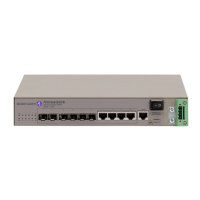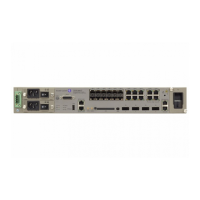Virtual Private LAN Services
7210 SAS M Services Guide Page 399
edge-port
Syntax [no] edge-port
Context config>service>vpls>sap>stp
config>service>vpls>spoke-sdp>stp
Description This command configures the SAP or SDP as an edge or non-edge port. If auto-edge is enabled for
the SAP, this value will be used only as the initial value.
RSTP, however, can detect that the actual situation is different from what edge-port may indicate.
Initially, the value of the SAP or spoke SDP parameter is set to edge-port. This value will change if:
• A BPDU is received on that port. This means that after all there is another bridge connected to
this port. Then the edge-port becomes disabled.
• If auto-edge is configured and no BPDU is received within a certain period of time, RSTP con-
cludes that it is on an edge and enables the edge-port.
The no form of this command returns the edge port setting to the default value.
Default no edge-port
forward-delay
Syntax forward-delay seconds
no forward-delay
Context config>service>vpls>stp
config>template>vpls-template>stp
Description RSTP, as defined in the IEEE 802.1D-2004 standards, will normally transition to the forwarding state
via a handshaking mechanism (rapid transition), without any waiting times. If handshaking fails (e.g.
on shared links, see below), the system falls back to the timer-based mechanism defined in the
original STP (802.1D-1998) standard.
A shared link is a link with more than two nodes (for example, a shared 10/100BaseT segment). The
port-type command is used to configure a link as point-to-point or shared.
For timer-based transitions, the 802.1D-2004 standard defines an internal variable forward-delay,
which is used in calculating the default number of seconds that a SAP spends in the discarding and
learning states when transitioning to the forwarding state.
The value of the forward-delay variable depends on the STP operating mode of the VPLS instance:
•in rstp or mstp mode, but only when the SAP has not fallen back to legacy STP operation, the
value configured by the hello-time command is used;
• in all other situations, the value configured by the forward-delay command is used.
Default 15 seconds
Parameters seconds — The forward delay timer for the STP instance in seconds.
Values 4 — 30

